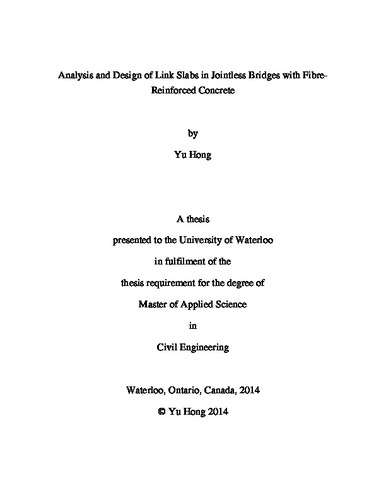| dc.description.abstract | Many transportation agencies in Canada and the United States have explored alternatives to expansion joints in bridges due to high maintenance costs and poor joint durability. One of the alternatives is the use of link slab in a jointless bridge, which connects the adjacent bridge deck slabs at the pier, forming a continuous slab across the bridge spans. While the link slab system can provide the benefits of a continuous bridge deck, refinement of the design and detailing of the link slab itself is needed to optimize this bridge deck system and ensure long-term performance. Materials with high tensile strain capacity, such as fibre reinforced concrete (FRC), can be used for application in the link slab to improve the strength, durability and cracking characteristics of the link slab.
In this study, four steps are used to address the research objectives. The first step of this research is to establish a computational model of an existing bridge (Camlachie Road Underpass). It is found that the model and modelling approach in SAP2000 closely predicted the field test results obtained by the Ministry of Transportation of Ontario (MTO). Additionally, it is established that the horizontal stiffness of the elastomeric bearings is very low and therefore the supports are representative of roller supports. Therefore, axial forces are not generated when there are no horizontal restraints in the supports.
The second step is to examine the properties of FRC from experimental tests. Four-point bending tests are used to estimate the ultimate and service stresses of FRC using procedures from the fib Model Code (2010). It is found that the results from the fib Model Code are in agreement with the experimental beam tests by Cameron. Therefore, it is concluded that the fib Model Code procedures are valid for calculating the ultimate and service stresses in FRC, and are used in the computational and analytical models.
The third step is to conduct a parametric study to provide a better understanding of link slab bridge behaviour to assess the impact of design decisions on the bridge response. It is found that the use of hooked steel fibres minimized the crack width of the link slab, and a debonded length a 5% to 7.5% is found to be optimal based on cost and serviceability. Moreover, it is found that fibres are more effective when less steel reinforcements are used in the link slab. Lastly, a parametric study is conducted on the computational model using non-linear analysis by including FRC in the computational model in the form of plastic hinges. It is concluded that the computational model has shown signs of cracking at the pier supports, which is consistent with the site observations during the MTO field test for the Camlachie Road Underpass.
The final step is developing an analytical model (i.e., design guideline) on the analysis and design of link slab bridges with FRC. It is found that the proposed analytical model is able to closely represent the link slab bridge behaviour with very small difference (2-3%), whereas the current method of analysis using Caner and Zia’s approach shows a larger prediction error (16%). For the link slab design with FRC, it is found that fibres in reinforced concrete helped increase the bending moment capacity of the link slab by more than 10% compared to normal reinforced concrete (without fibres). The use of polypropylene fibres and hooked steel fibres in the link slab reduces the required steel reinforcement by 3.5% and 21%, respectively, and the crack width of the link slab reduces by more than 3 times with the addition of fibres. | en |

